Metal Matrix Composite Coatings Deposited by Laser Cladding: On the Effectiveness of WC Reinforcement for Wear Resistance and Its Synergy with the Matrix Material (Ni Versus Co Alloys)
Abstract
:1. Introduction
| Process | Substrate | Coating | WC Shape | WC Size (μm) | WC Amount | Dilution | Hardness | Wear Test | Wear Performance | Ref. |
|---|---|---|---|---|---|---|---|---|---|---|
| HVOF 1 | AISI 316L | Inconel 625 | - | - | 22–42% | - | 250–610 HV | Pin-on-disc | Increased 92% | [15] |
| Laser cladding | TWZ-2 (steel) | Inconel 625 | Spherical | 4–105 | 15–30% | - | 258–466 HV1 | Reciprocating | Increased 65% | [6] |
| Laser cladding | Q235 (steel) | Inconel 625 | Spherical and angular | 15–45 | 15% | - | 311–429 HV0.2 | Pin-on-disc | Increased 86% | [9] |
| Laser cladding | AISI 304 | Inconel 625 | Spherical and angular | 100–200 | 30% | 28–42% | 230–500 HV0.2 | Erosion | Increased 43% | [10] |
| Laser cladding | Q235 (steel) | Inconel 625 | Angular | ~0.1 | 2–10% | - | 230–500 HV0.2 | Block-on-disc | Increased 45% | [11] |
| Laser cladding | AISI 1045 | Inconel 625 | Spherical | - | 35–65% | 13–42% | 843 HV | Reciprocating | Increased 84% | [16] |
| Laser cladding | SM400B (steel) | Stellite 6 | Spherical | >45 | 0–47% | - | 590–800 HV0.05 | - | No variation | [12] |
| Laser cladding | 60Si2Mn (steel) | Stellite 6 | Angular | 65–245 | 30% | - | 380–732 HV0.1 | Pin-on-disc | Increased 60% | [13] |
| Laser cladding | AISI H13 | Stellite 6 | Spherical | 45–106 | 30% | - | 600–660 HV0.01 | - | Increased 39% | [17] |
| Laser Cladding | S355 (steel) | Stellite 6 | Angular | >100 | 60% | - | 550–580 HV0.05 | Block-on-ring | Increased 90% | [18] |
| PTA 2 | AISI 1020 | Stellite 6 | Angular | 35 | 35% | 12–18% | 430–650 HV0.5 | Pin-on-disc | Increased | [19] |
| PTA 2 | Q235 (steel) | NiCrMo | Angular | - | 5–20% | - | 500–580 HV | Ball-on-disc | Increased 42% | [20] |
| PTA 2 | Cr5 steel | 18Ni300 | Spherical | 45–105 | 5% | 10–12% | 350–400 HV0.3 | - | Increased 56% | [21] |
| PTA 2 | AISI 1044 | AISI 420 | Spherical | 45–125 | 15–45% | - | 590–620 HV0.5 | Ball-on-disc | Increased | [22] |
| Laser cladding | AISI 304 | AlCoCrFeNi | Spherical | 35–135 | 10–40% | - | 351–426 HV0.3 | Ball-on-disc | Increased | [23] |
| Laser Cladding | AISI 304 | Ni alloy | Spherical | 35–145 | 10–60% | - | 301–502 HV | Ball-on-disc | Increased 88% | [8] |
| HVOF 1 | AISI 1018 | Woka 3603 | Angular | - | 10–30% | - | 202–1421 HV0.3 | Erosion | Decreased 16% | [24] |
| Laser Cladding | AISI 304 | FeCrNiMnAl | Angular | - | 5–20% | - | - | Erosion | Decreased 28% | [25] |
2. Materials and Methods
2.1. Deposition of the Coatings
2.2. Characterization of the Coatings
2.3. The Wear Performance of the Coatings
3. Results
3.1. General Characterization of the Coatings
3.2. Evaluation of the Abrasive Wear Resistance of the Coatings
4. Discussion
Reinforcement–Matrix Sinergy: Design Reflections on MMC Caotings and Research Outlook
5. Conclusions
- ➢
- The WC presence increases the dilution index (the mixing of the coating and substrate) with both matrix materials (Inconel 625 and Stellite 6);
- ➢
- The WC particles tend to crack within an Inconel 625 matrix;
- ➢
- The WC particles increase both the hardness and wear resistance in coatings based on Stellite 6, resulting in reinforcement–matrix synergy;
- ➢
- The WC particles increase the hardness but reduce the wear resistance in coatings based on Inconel 625, which does not result in reinforcement–matrix synergy.
Supplementary Materials
Author Contributions
Funding
Institutional Review Board Statement
Informed Consent Statement
Data Availability Statement
Acknowledgments
Conflicts of Interest
Abbreviations
| HVOF | High Velocity Oxygen Fuel |
| OM | Optical microscopy |
| PMI XRF | Positive Material Identification by X-Ray Fluorescence |
| PTA | Plasma Transferred Arc |
| SEM | Scanning electron microscopy |
| WC | Tungsten carbide |
References
- Quintino, L. Overview of Coating Technologies. In Surface Modification by Solid State Processing; Woodhead Publishing Limited: Sawston, UK, 2014; ISBN 9780857094681. [Google Scholar]
- Toyserkani, E.; Khajepour, A.; Corbin, S. Laser Cladding; CRC Press: Boca Raton, FL, USA, 2017; Volume 11, ISBN 0849321727. [Google Scholar]
- Luo, D.; Liu, C.; Wang, C.; Wang, Y.; Wang, X.; Zhao, J.; Jiang, S. Optimization of Multilayer Laser Cladding Process Parameters Based on NSGA-II-MOPSO Algorithm. Opt. Laser Technol. 2024, 176, 111025. [Google Scholar] [CrossRef]
- Su, G.; Shi, Y.; Li, G.; Xu, Y. High-Efficiency Fabrication of Inconel 625 Coating for AISI 1045 Carbon Steel through Laser Cladding with Hot Wire: Microstructure and Wear Resistance. J. Manuf. Process. 2023, 102, 622–631. [Google Scholar] [CrossRef]
- Zhu, L.; Xue, P.; Lan, Q.; Meng, G.; Ren, Y.; Yang, Z.; Xu, P.; Liu, Z. Recent Research and Development Status of Laser Cladding: A Review. Opt. Laser Technol. 2021, 138, 106915. [Google Scholar] [CrossRef]
- Zhang, K.; Ju, H.; Xing, F.; Wang, W.; Li, Q.; Yu, X.; Liu, W. Microstructure and Properties of Composite Coatings by Laser Cladding Inconel 625 and Reinforced WC Particles on Non-Magnetic Steel. Opt. Laser Technol. 2023, 163, 109321. [Google Scholar] [CrossRef]
- Bartkowski, D.; Bartkowska, A. Wear Resistance in the Soil of Stellite-6/WC Coatings Produced Using Laser Cladding Method. Int. J. Refract. Met. Hard Mater. 2017, 64, 20–26. [Google Scholar] [CrossRef]
- Hu, Z.; Li, Y.; Lu, B.; Tan, N.; Cai, L.; Yong, Q. Effect of WC Content on Microstructure and Properties of High-Speed Laser Cladding Ni-Based Coating. Opt. Laser Technol. 2022, 155, 108449. [Google Scholar] [CrossRef]
- Li, W.; Di, R.; Yuan, R.; Song, H.; Lei, J. Microstructure, Wear Resistance and Electrochemical Properties of Spherical/Non-Spherical WC Reinforced Inconel 625 Superalloy by Laser Melting Deposition. J. Manuf. Process. 2022, 74, 413–422. [Google Scholar] [CrossRef]
- Janicki, D.; Musztyfaga-Staszuk, M. Direct Diode Laser Cladding of Inconel 625/WC Composite Coatings. Stroj. Vestnik–J. Mech. Eng. 2016, 62, 363–372. [Google Scholar] [CrossRef]
- Wang, T.; An, Y.; Sun, P.; Zhao, W.; Zhou, L.; Liu, X. Impact of Different Nanosized-WC Contents on the Microstructure and Wear Resistance of Direct Energy Deposition Inconel 625/WC Composites by Circular Beam Oscillating Laser. Ceram. Int. 2025, in press. [Google Scholar] [CrossRef]
- Xu, G.; Kutsuna, M.; Liu, Z.; Sun, L. Characteristic Behaviours of Clad Layer by a Multi-Layer Laser Cladding with Powder Mixture of Stellite-6 and Tungsten Carbide. Surf. Coatings Technol. 2006, 201, 3385–3392. [Google Scholar] [CrossRef]
- Wu, T.; Shi, W.; Xie, L.; Gong, M.; Huang, J.; Xie, Y.; He, K. Effect of Preheating Temperature on Geometry and Mechanical Properties of Laser Cladding-Based Stellite 6/WC Coating. Materials 2022, 15, 3952. [Google Scholar] [CrossRef] [PubMed]
- Wang, G.; Zhang, J.; Shu, R.; Yang, S. High Temperature Wear Resistance and Thermal Fatigue Behavior of Stellite-6/WC Coatings Produced by Laser Cladding with Co-Coated WC Powder. Int. J. Refract. Met. Hard Mater. 2019, 81, 63–70. [Google Scholar] [CrossRef]
- Liu, Z.; Cabrero, J.; Niang, S.; Al-Taha, Z.Y. Improving Corrosion and Wear Performance of HVOF-Sprayed Inconel 625 and WC-Inconel 625 Coatings by High Power Diode Laser Treatments. Surf. Coatings Technol. 2007, 201, 7149–7158. [Google Scholar] [CrossRef]
- Meng, L.; Zhu, B.; Liu, X.; Zeng, X. Investigation on the Ni60-WC Composite Coatings Deposited by Extreme-High-Speed Laser-Induction Hybrid Cladding Technology: Forming Characteristics, Microstructure and Wear Behaviors. Surf. Coatings Technol. 2023, 473, 130033. [Google Scholar] [CrossRef]
- Karmakar, D.P.; Muvvala, G.; Nath, A.K. High-Temperature Abrasive Wear Characteristics of H13 Steel Modified by Laser Remelting and Cladded with Stellite 6 and Stellite 6/30% WC. Surf. Coatings Technol. 2021, 422, 127498. [Google Scholar] [CrossRef]
- Bartkowski, D.; Kinal, G. Microstructure and Wear Resistance of Stellite-6/WC MMC Coatings Produced by Laser Cladding Using Yb:YAG Disk Laser. Int. J. Refract. Met. Hard Mater. 2016, 58, 157–164. [Google Scholar] [CrossRef]
- D’Oliveira, A.S.C.M.; Tigrinho, J.J.; Takeyama, R.R. Coatings Enrichment by Carbide Dissolution. Surf. Coatings Technol. 2008, 202, 4660–4665. [Google Scholar] [CrossRef]
- Yin, H.; Song, W.; Liu, Q.; Zhu, G.; Zhang, J.; Yu, Y.; Yin, C. Effect of Different Contents of WC on Microstructure and Properties of NiCrMo Coatings Prepared by PTA. Coatings 2022, 12, 1574. [Google Scholar] [CrossRef]
- Yi, J.; Niu, B.; Pan, L.; Zou, X.; Cao, Y.; Wang, X.; Luo, J.; Hu, Y. Influence of WC Grain Size on the Microstructure and Wear Property Enhancement of 18Ni300 Coatings. Surf. Coatings Technol. 2022, 447, 128823. [Google Scholar] [CrossRef]
- Zhou, Y.; Liu, Y.; Huang, Z.; Wang, S.; Yue, Z.; Zhang, W.; Kong, D.; Zhou, W.; Yu, W.; Shang, F.; et al. Microstructure, Wear, and Corrosion Performance of Spherical Cast Tungsten Carbide Reinforced Stainless Steel-Based Composites Manufactured by Plasma Transferred Arc Techniques. Vacuum 2025, 233, 114003. [Google Scholar] [CrossRef]
- Li, Y.; Yu, Y.; Wang, J.; Yu, Q.; Tan, N.; Zhang, G.; Qi, J.; Yin, Y.; Cai, Y. Effect of WC Content on the Microstructure and Properties of AlCoCrFeNi2.1 Eutectic High Entropy Alloy Coating Prepared by Ultra-High Speed Laser Cladding Technology. Mater. Today Commun. 2024, 41, 110259. [Google Scholar] [CrossRef]
- Maiti, A.K.; Mukhopadhyay, N.; Raman, R. Effect of Adding WC Powder to the Feedstock of WC–Co–Cr Based HVOF Coating and Its Impact on Erosion and Abrasion Resistance. Surf. Coatings Technol. 2007, 201, 7781–7788. [Google Scholar] [CrossRef]
- Yu, D.T.; Wang, R.; Wu, C.L.; Wang, Z.Z.; Zhao, X.B.; Zhang, S.; Zhang, C.H.; Tao, X.P. Wear, Corrosion and Cavitation Erosion Behavior of WC-Reinforced FeCrNiMnAl Ceramic-High Entropy Alloy Composite Coatings by Laser Cladding. Ceram. Int. 2024, 50, 55790–55800. [Google Scholar] [CrossRef]
- ASTM Standard B611; Standard Test Method for Determining the High Stress Abrasion Resistance of Hard Materials. American Society for Testing and Materials: West Conshohocken, PA, USA, 2013; pp. 1–7. [CrossRef]
- Li, X.; Zhang, S.; Liu, W.; Pang, X.; Tong, Y.; Zhang, M.; Zhang, J.; Wang, K. Effect of WC Content on the Wear and Corrosion Properties of Oscillating Laser-Cladding-Produced Nickel-Based Coating. Coatings 2023, 13, 1614. [Google Scholar] [CrossRef]
- Wang, J.; Zhou, J.; Zhang, T.; Meng, X.; Li, P.; Huang, S.; Zhu, H. Ultrasonic-Induced Grain Refinement in Laser Cladding Nickel-Based Superalloy Reinforced by WC Particles. Coatings 2023, 13, 151. [Google Scholar] [CrossRef]
- Zeng, S.; Jin, Y.; Zhou, R.; Wu, X.; Su, W.; Tang, X. Strengthening and Toughening of WC-Ni Alloys by Adding Novel (Ti, Hf, Ta, Nb, Zr)(C, N) High Entropy Powder. Int. J. Refract. Met. Hard Mater. 2024, 118, 106436. [Google Scholar] [CrossRef]
- Sebastiani, M.; Mangione, V.; De Felicis, D.; Bemporad, E.; Carassiti, F. Wear Mechanisms and In-Service Surface Modifications of a Stellite 6B Co-Cr Alloy. Wear 2012, 290–291, 10–17. [Google Scholar] [CrossRef]
- Kołodziejczak, P.; Bober, M.; Chmielewski, T. Wear Resistance Comparison Research of High-Alloy Protective Coatings for Power Industry Prepared by Means of CMT Cladding. Appl. Sci. 2022, 12, 4568. [Google Scholar] [CrossRef]
- Ferreira Filho, D.; Souza, D.; Gonçalves Júnior, J.L.; Reis, R.P.; Da Silva Junior, W.M.; Tavares, A.F. Influence of Substrate on the Tribological Behavior of Inconel 625 GMAW Overlays. Coatings 2023, 13, 1454. [Google Scholar] [CrossRef]
- Dubey, D.; Mukherjee, R.; Singh, M.K. A Review on Tribological Behavior of Nickel-Based Inconel Superalloy. Proc. Inst. Mech. Eng. Part J J. Eng. Tribol. 2024, 238, 706–732. [Google Scholar] [CrossRef]









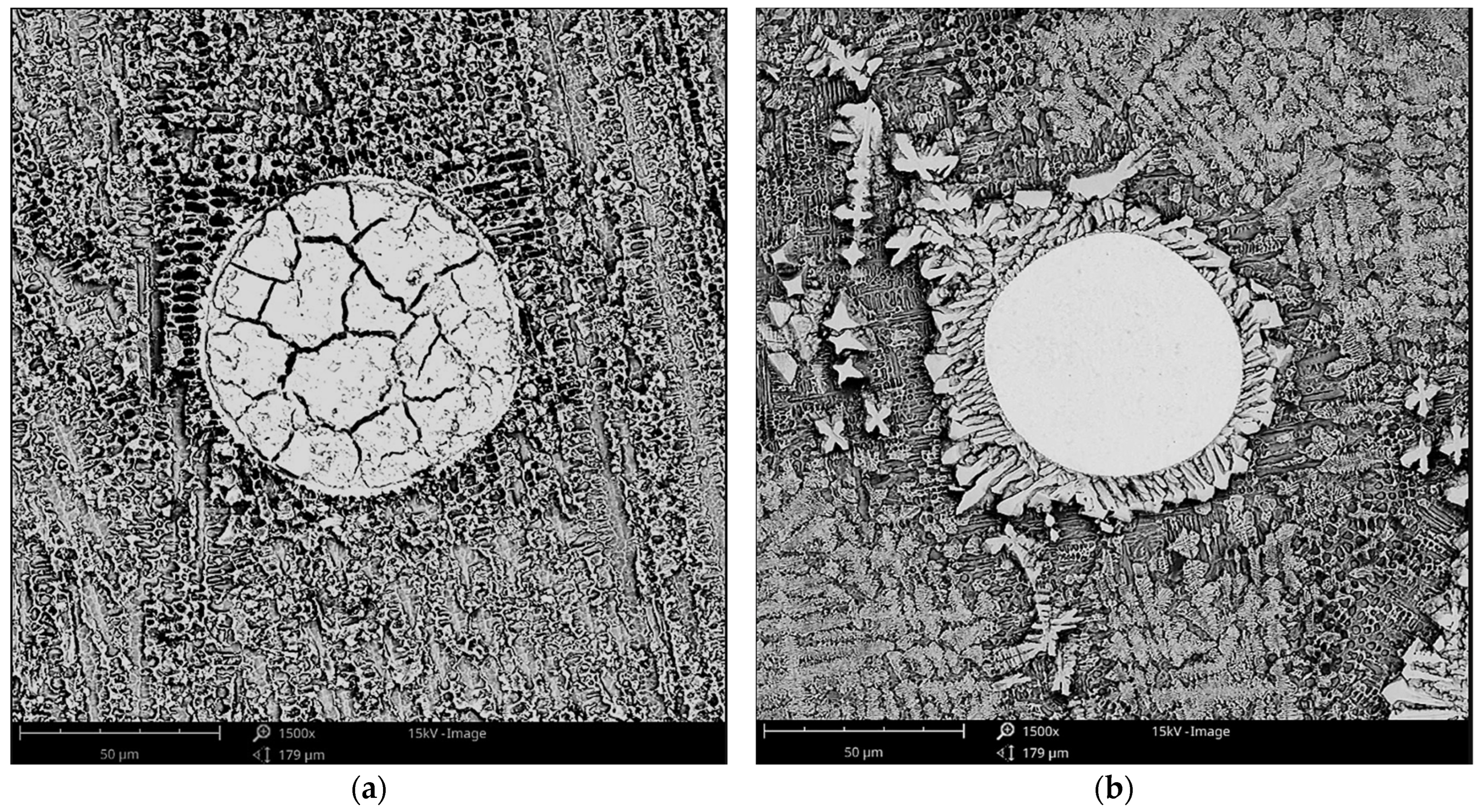
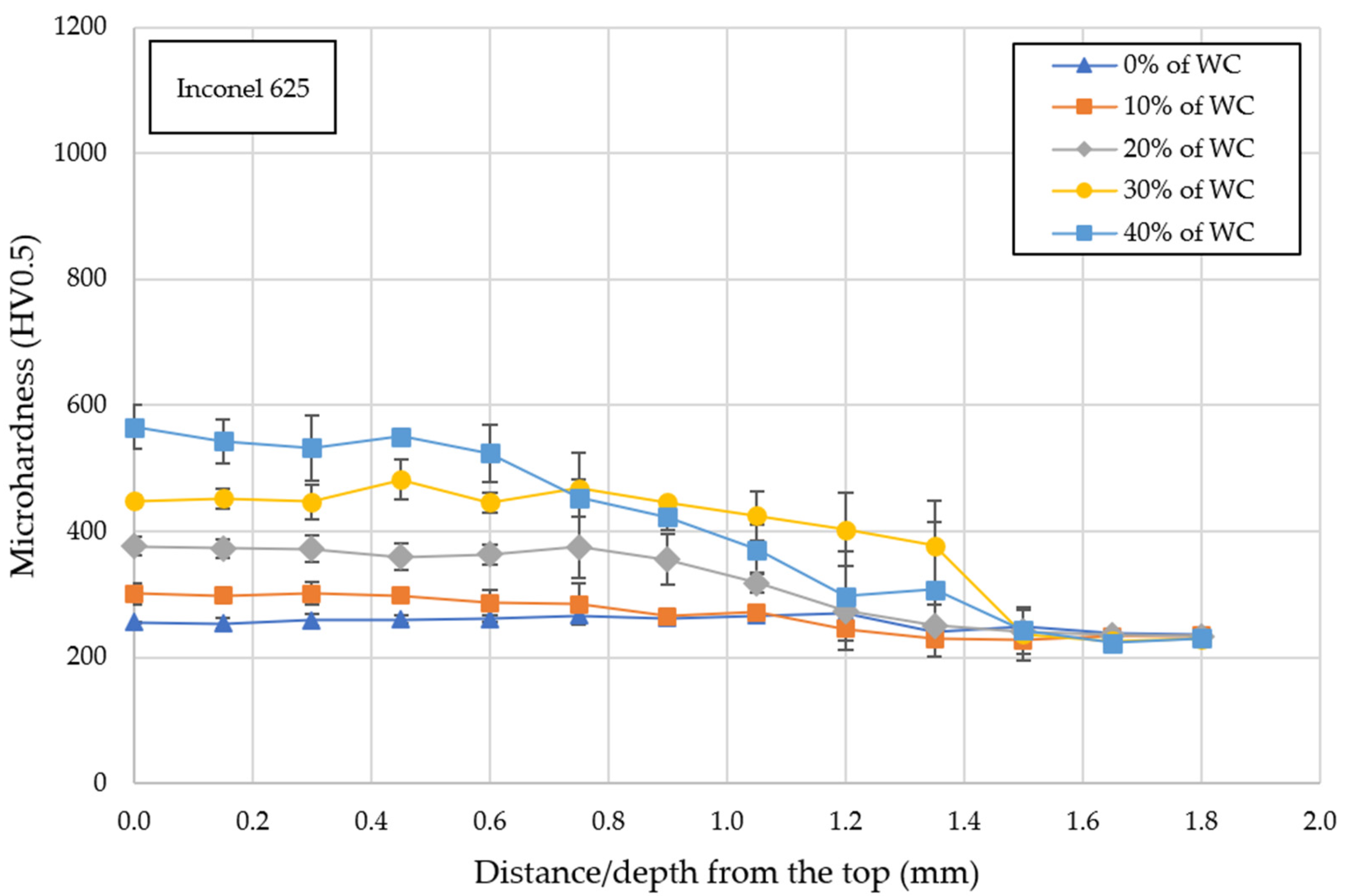
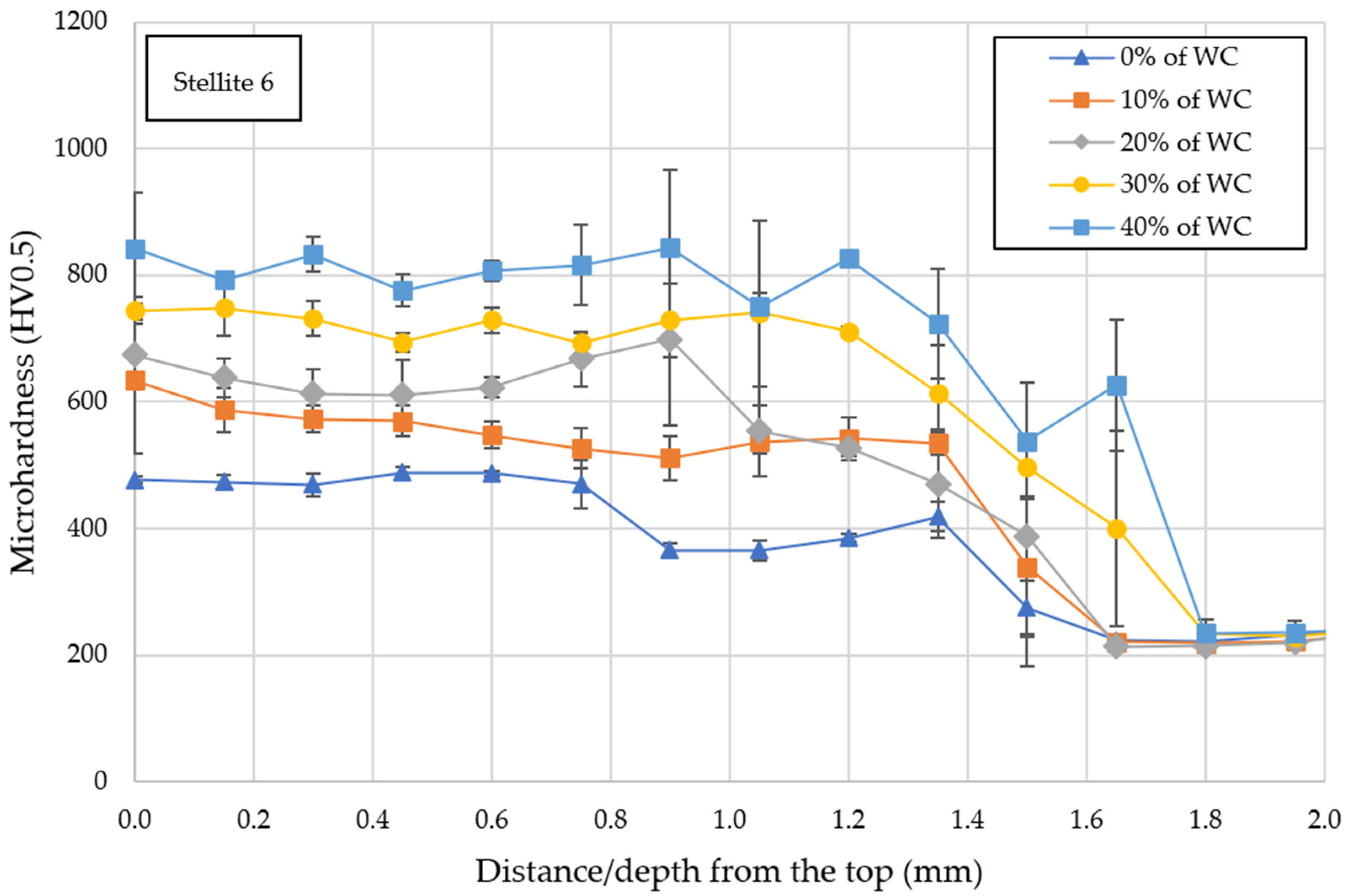

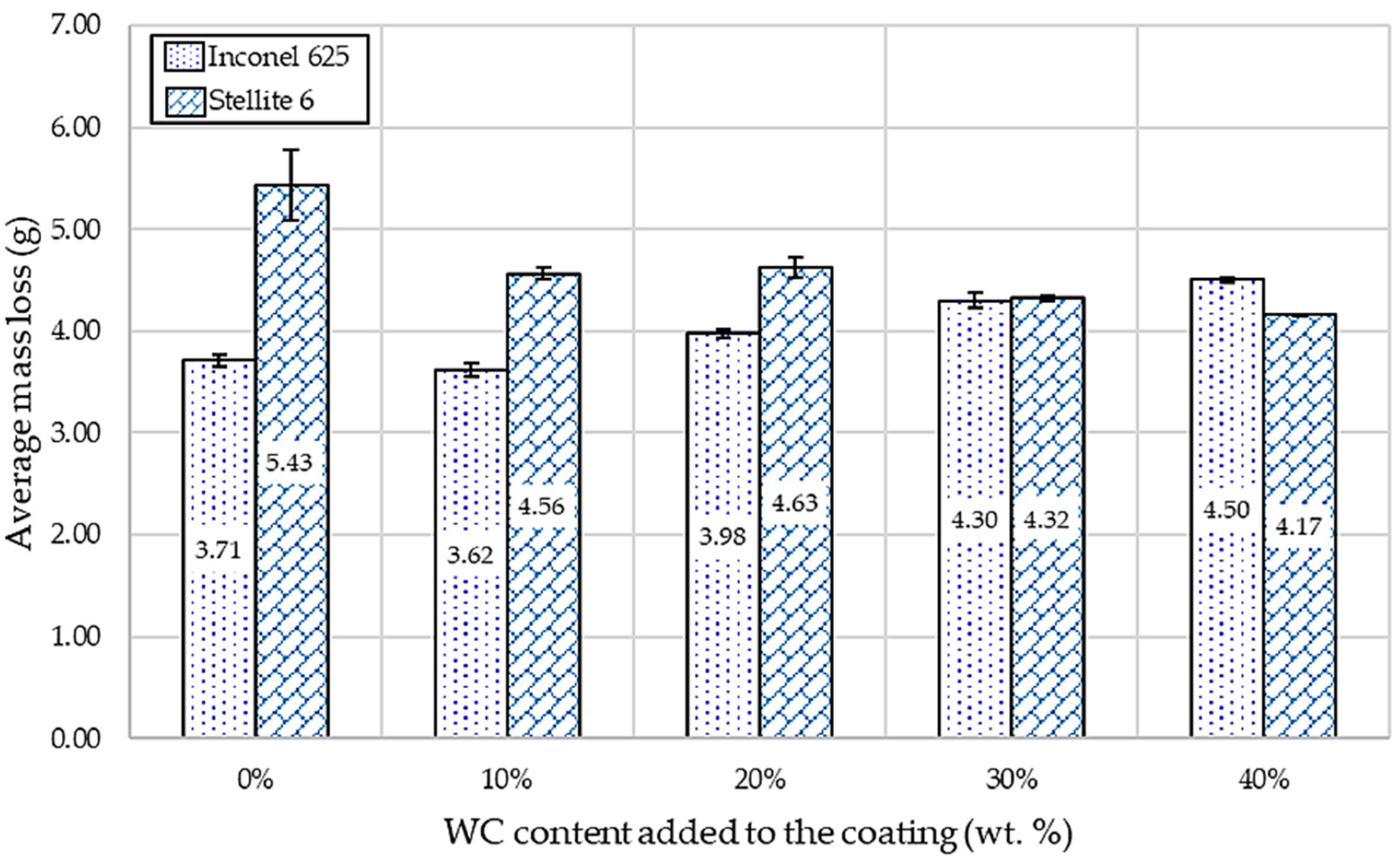

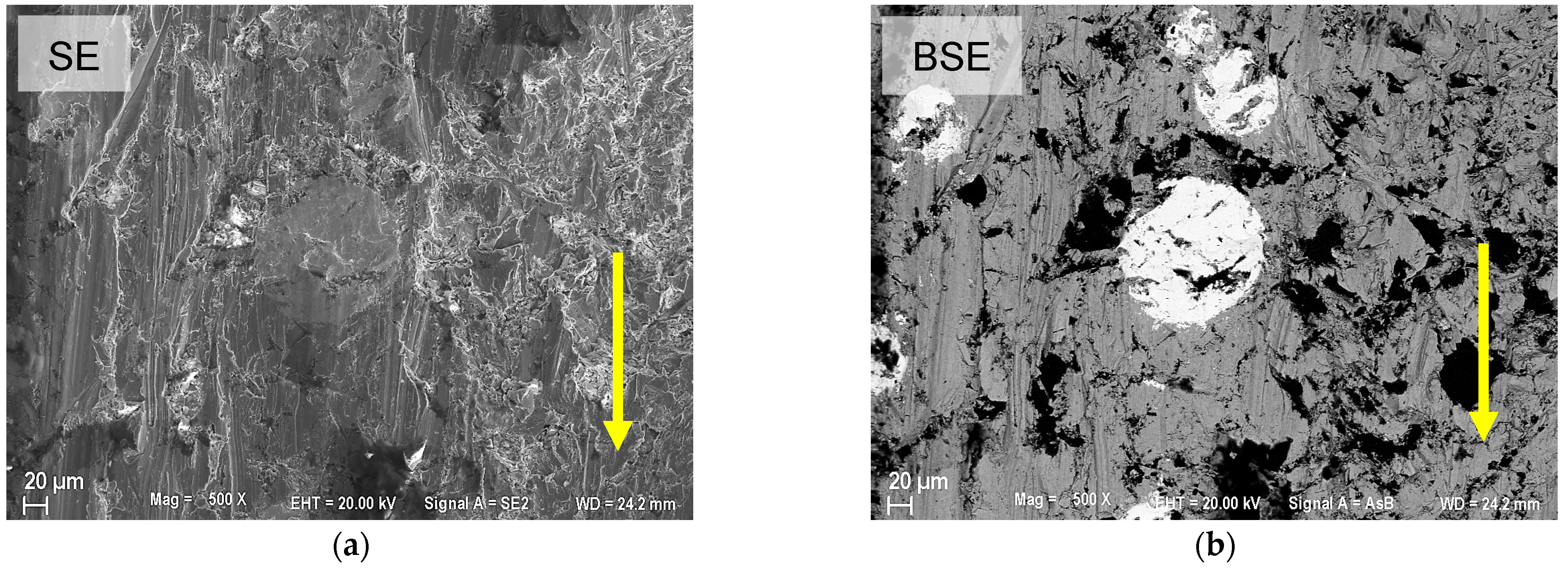
| Material | Ni (%) | Cr (%) | Mo (%) | Fe (%) | Mn (%) | Si (%) | C (%) |
|---|---|---|---|---|---|---|---|
| IN625 | Bal. | 21.1 | 8.9 | 0.7 | 0.4 | 0.4 | 0.03 |
| Material | Co (%) | Cr (%) | W (%) | Ni (%) | Si (%) | Fe (%) | C (%) |
|---|---|---|---|---|---|---|---|
| ST6 | Bal. | 28 | 4.5 | 1.0 | 1.1 | 0.6 | 1.0 |
| Material | W (%) | C (%) | Others (%) |
|---|---|---|---|
| WC | Bal. | 3.8 | 0.7 |
| Material | Fe (%) | Cr (%) | Ni (%) | Co (%) | Mn (%) | Cu (%) |
|---|---|---|---|---|---|---|
| AISI 304 | 70.4 | 18.6 | 8.2 | 0.3 | 1.6 | 0.5 |
| Laser power | 3130 W |
| Laser spot diameter on substrate | 5 mm |
| Travel speed | 1720 mm/min |
| Powder feed rate | 40 g/min |
| Shielding gas and carrier gas flow rate | Argon at 8 L/min |
| Lateral overlap | 30% |
| Wheel rotation speed | 100 rpm |
| Number of cycles | 1000 |
| Test duration | 10 min |
| Normal load | 200 N |
| Abrasive | Alumina (30 mesh~600 μm) with water in a 2:1 ratio (slurry) |
| Wheel | SAE 1020 steel with average hardness of 91.4 ± 0.2, width of 12.7 ± 0.1 mm, and diameter of 165–169 ± 0.1 mm |
| WC Addition | Ni (%) | Cr (%) | Mo (%) | Nb (%) | Fe (%) | Mn (%) | W (%) |
|---|---|---|---|---|---|---|---|
| 0% | 62.2 | 21.6 | 9.4 | 3.5 | 2.7 | 0.4 | - |
| 10% | 50.8 | 20.3 | 7.8 | 3.4 | 8.4 | 0.5 | 8.60 |
| 20% | 47.8 | 19.1 | 7.1 | 2.9 | 10.52 | 0.6 | 11.80 |
| 30% | 43.3 | 18.1 | 6.5 | 3.1 | 11.2 | 0.6 | 17.00 |
| 40% | 33.7 | 16.2 | 5.0 | 2.8 | 15.1 | 0.7 | 26.60 |
| WC Addition | Co (%) | Cr (%) | W (%) | Ni (%) | Fe (%) |
|---|---|---|---|---|---|
| 0% | 60.4 | 28.6 | 7.6 | 1.2 | 1.9 |
| 10% | 54.9 | 27.5 | 13.0 | 1.35 | 3.3 |
| 20% | 47.6 | 25.2 | 19.9 | 1.54 | 5.4 |
| 30% | 41.0 | 22.8 | 27.1 | 1.49 | 7.23 |
| 40% | 29.8 | 18.9 | 31.8 | 2.3 | 17.2 |
Disclaimer/Publisher’s Note: The statements, opinions and data contained in all publications are solely those of the individual author(s) and contributor(s) and not of MDPI and/or the editor(s). MDPI and/or the editor(s) disclaim responsibility for any injury to people or property resulting from any ideas, methods, instructions or products referred to in the content. |
© 2025 by the authors. Licensee MDPI, Basel, Switzerland. This article is an open access article distributed under the terms and conditions of the Creative Commons Attribution (CC BY) license (https://creativecommons.org/licenses/by/4.0/).
Share and Cite
da Silva, L.J.; Pacheco, J.T.; Moura, E.I.F.; de Araújo, D.B.; Reis, R.P.; D’Oliveira, A.S.C.M. Metal Matrix Composite Coatings Deposited by Laser Cladding: On the Effectiveness of WC Reinforcement for Wear Resistance and Its Synergy with the Matrix Material (Ni Versus Co Alloys). Coatings 2025, 15, 468. https://doi.org/10.3390/coatings15040468
da Silva LJ, Pacheco JT, Moura EIF, de Araújo DB, Reis RP, D’Oliveira ASCM. Metal Matrix Composite Coatings Deposited by Laser Cladding: On the Effectiveness of WC Reinforcement for Wear Resistance and Its Synergy with the Matrix Material (Ni Versus Co Alloys). Coatings. 2025; 15(4):468. https://doi.org/10.3390/coatings15040468
Chicago/Turabian Styleda Silva, Leandro João, Jeferson Trevizan Pacheco, Edja Iandeyara Freitas Moura, Douglas Bezerra de Araújo, Ruham Pablo Reis, and Ana Sofia Clímaco Monteiro D’Oliveira. 2025. "Metal Matrix Composite Coatings Deposited by Laser Cladding: On the Effectiveness of WC Reinforcement for Wear Resistance and Its Synergy with the Matrix Material (Ni Versus Co Alloys)" Coatings 15, no. 4: 468. https://doi.org/10.3390/coatings15040468
APA Styleda Silva, L. J., Pacheco, J. T., Moura, E. I. F., de Araújo, D. B., Reis, R. P., & D’Oliveira, A. S. C. M. (2025). Metal Matrix Composite Coatings Deposited by Laser Cladding: On the Effectiveness of WC Reinforcement for Wear Resistance and Its Synergy with the Matrix Material (Ni Versus Co Alloys). Coatings, 15(4), 468. https://doi.org/10.3390/coatings15040468







